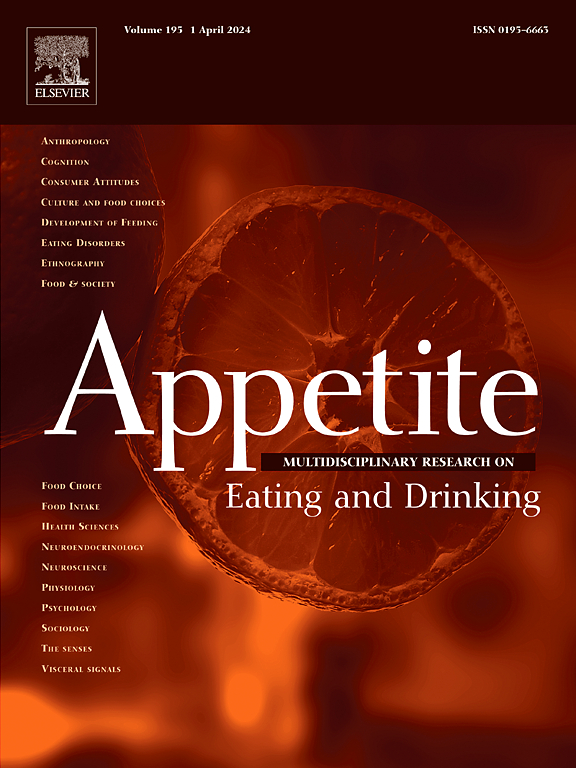Testing the acceptance model of intuitive eating for explaining intuitive eating dimensions and sex differences in Chinese adults
IF 3.8
2区 医学
Q1 BEHAVIORAL SCIENCES
引用次数: 0
Abstract
The acceptance model of intuitive eating posits that unconditional acceptance and body acceptance by others foster functionality appreciation and body appreciation, which, in turn, promote intuitive eating. Although the model has been tested and supported in many empirical studies, most have focused on female adults in Western contexts and treated the multidimensional construct of intuitive eating as a global construct. Consequently, it remains unclear whether the model applies to both male and female adults or whether the model explains different variances in the distinct dimensions of intuitive eating, particularly in non-Western contexts (e.g., China). Thus, the present study aimed to address these gaps by testing the model in a sample of Chinese male (N = 377) and female (N = 355) adults and by applying the model to explain the four distinct dimensions of intuitive eating (i.e., Unconditional Permission to Eat [UPE], Eating for Physical Rather Than Emotional Reasons [EPR], Reliance on Hunger and Satiety Cues [RHSC], and Body-Food Choice Congruence [BFCC]). Path analysis was conducted to evaluate the model for male and female adults and test sex differences. Results showed adequate fit for both male and female adults. Specifically, in both male and female adults, unconditional acceptance was positively related to body acceptance from others. Body acceptance by others was positively associated with body appreciation. Emphasis on body function was positively correlated with some intuitive eating dimensions. Significant sex differences were identified in the path from unconditional acceptance to BFCC. The findings suggest that the acceptance model of intuitive eating operates uniquely in Chinese male and female adults and offer insights for future research to enhance the model and interventions related to intuitive eating in the Chinese context.
检验直觉饮食的接受模型对中国成年人直觉饮食维度和性别差异的解释
直觉性饮食的接受模型认为,他人无条件的接受和身体的接受促进了功能欣赏和身体欣赏,而功能欣赏和身体欣赏反过来又促进了直觉性饮食。尽管该模型已经在许多实证研究中得到了测试和支持,但大多数研究都集中在西方背景下的女性成年人身上,并将直觉饮食的多维结构视为一种全球结构。因此,尚不清楚该模型是否适用于男性和女性成年人,或者该模型是否解释了直觉饮食的不同维度的不同差异,特别是在非西方环境中(例如,中国)。因此,本研究旨在通过在中国男性(N = 377)和女性(N = 355)成年人样本中测试该模型,并应用该模型解释直觉饮食的四个不同维度(即无条件允许进食[UPE]、身体而非情感原因进食[EPR]、对饥饿和饱腹感线索的依赖[RHSC]和身体-食物选择一致性[BFCC])来解决这些差距。通过通径分析对男女成虫的模型进行评价,并检验性别差异。结果显示,男性和女性成年人都适合。具体而言,在男性和女性成年人中,无条件接受与他人对身体的接受呈正相关。他人对身体的接受与对身体的欣赏呈正相关。对身体功能的重视与一些直观的饮食维度呈正相关。在从无条件接受到BFCC的过程中发现了显著的性别差异。研究结果表明,直觉饮食的接受模式在中国男性和女性成年人中具有独特的运作方式,并为未来研究在中国背景下加强与直觉饮食相关的模型和干预提供了见解。
本文章由计算机程序翻译,如有差异,请以英文原文为准。
求助全文
约1分钟内获得全文
求助全文
来源期刊

Appetite
医学-行为科学
CiteScore
9.10
自引率
11.10%
发文量
566
审稿时长
13.4 weeks
期刊介绍:
Appetite is an international research journal specializing in cultural, social, psychological, sensory and physiological influences on the selection and intake of foods and drinks. It covers normal and disordered eating and drinking and welcomes studies of both human and non-human animal behaviour toward food. Appetite publishes research reports, reviews and commentaries. Thematic special issues appear regularly. From time to time the journal carries abstracts from professional meetings. Submissions to Appetite are expected to be based primarily on observations directly related to the selection and intake of foods and drinks; papers that are primarily focused on topics such as nutrition or obesity will not be considered unless they specifically make a novel scientific contribution to the understanding of appetite in line with the journal's aims and scope.
 求助内容:
求助内容: 应助结果提醒方式:
应助结果提醒方式:


